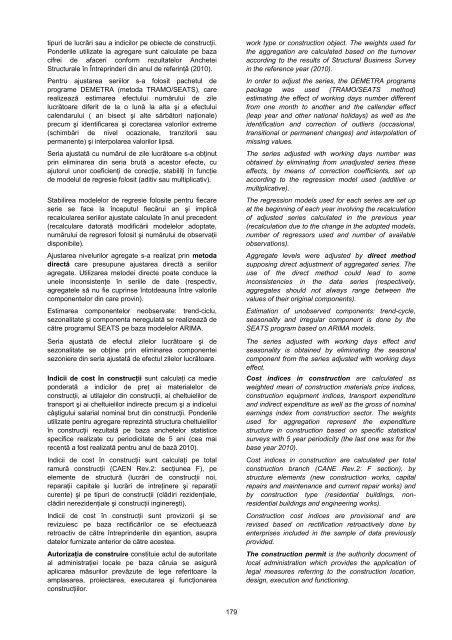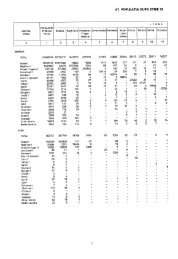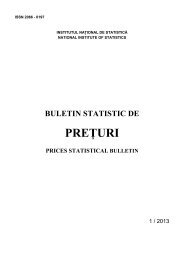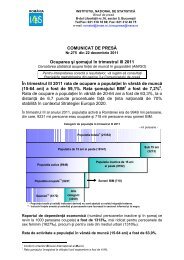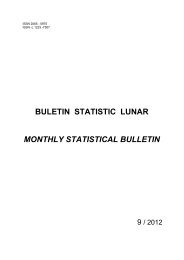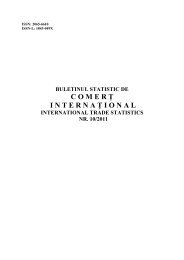tipuri <strong>de</strong> lucrări sau a indicilor pe obiecte <strong>de</strong> construcţii.Pon<strong>de</strong>rile utilizate la agregare sunt calculate pe bazacifrei <strong>de</strong> afaceri conform rezultatelor AncheteiStructurale în Întreprin<strong>de</strong>ri din anul <strong>de</strong> referinţă (2010).Pentru ajustarea seriilor s-a folosit pachetul <strong>de</strong>programe DEMETRA (metoda TRAMO/SEATS), carerealizează estimarea efectului numărului <strong>de</strong> zilelucrătoare diferit <strong>de</strong> la o lună la alta şi a efectuluicalendarului ( an bisect şi alte sărbători naţionale)precum şi i<strong>de</strong>ntificarea şi corectarea valorilor extreme(schimbări <strong>de</strong> nivel ocazionale, tranzitorii saupermanente) şi interpolarea valorilor lipsă.Seria ajustată cu numărul <strong>de</strong> zile lucrătoare s-a obţinutprin eliminarea din seria brută a acestor efecte, cuajutorul unor coeficienţi <strong>de</strong> corecţie, stabiliţi în funcţie<strong>de</strong> mo<strong>de</strong>lul <strong>de</strong> regresie folosit (aditiv sau multiplicativ).Stabilirea mo<strong>de</strong>lelor <strong>de</strong> regresie folosite pentru fiecareserie se face la începutul fiecărui an şi implicărecalcularea seriilor ajustate calculate în anul prece<strong>de</strong>nt(recalculare datorată modificării mo<strong>de</strong>lelor adoptate,numărului <strong>de</strong> regresori folosit şi numărului <strong>de</strong> observaţiidisponibile).Ajustarea nivelurilor agregate s-a realizat prin metodadirectă care presupune ajustarea directă a seriiloragregate. Utilizarea meto<strong>de</strong>i directe poate conduce launele inconsistenţe în seriile <strong>de</strong> date (respectiv,agregatele să nu fie cuprinse întot<strong>de</strong>auna între valorilecomponentelor din care provin).Estimarea componentelor neobservate: trend-ciclu,sezonalitate şi componenta neregulată se realizează <strong>de</strong>către programul SEATS pe baza mo<strong>de</strong>lelor ARIMA.Seria ajustată <strong>de</strong> efectul zilelor lucrătoare şi <strong>de</strong>sezonalitate se obţine prin eliminarea componenteisezoniere din seria ajustată <strong>de</strong> efectul zilelor lucrătoare.Indicii <strong>de</strong> cost în construcţii sunt calculaţi ca mediepon<strong>de</strong>rată a indicilor <strong>de</strong> preţ ai materialelor <strong>de</strong>construcţii, ai utilajelor din construcţii, ai cheltuielilor <strong>de</strong>transport şi ai cheltuielilor indirecte precum şi a indiceluicâştigului salarial nominal brut din construcţii. Pon<strong>de</strong>rileutilizate pentru agregare reprezintă structura cheltuielilorîn construcţii rezultată pe baza anchetelor statisticespecifice realizate cu periodicitate <strong>de</strong> 5 ani (cea mairecentă a fost realizată pentru anul <strong>de</strong> bază 2010).Indicii <strong>de</strong> cost în construcţii sunt calculaţi pe totalramură construcţii (CAEN Rev.2: secţiunea F), peelemente <strong>de</strong> structură (lucrări <strong>de</strong> construcţii noi,reparaţii capitale şi lucrări <strong>de</strong> intreţinere şi reparaţiicurente) şi pe tipuri <strong>de</strong> construcţii (clădiri rezi<strong>de</strong>nţiale,clădiri nerezi<strong>de</strong>nţiale şi construcţii inginereşti).Indicii <strong>de</strong> cost în construcţii sunt provizorii şi serevizuiesc pe baza rectificărilor ce se efectueazăretroactiv <strong>de</strong> către întreprin<strong>de</strong>rile din eşantion, asupradatelor furnizate anterior <strong>de</strong> către acestea.Autorizaţia <strong>de</strong> construire constituie actul <strong>de</strong> autoritateal administraţiei locale pe baza căruia se asigurăaplicarea măsurilor prevăzute <strong>de</strong> lege referitoare laamplasarea, proiectarea, executarea şi funcţionareaconstrucţiilor.work type or construction object. The weights used forthe aggregation are calculated based on the turnoveraccording to the results of Structural Business Surveyin the reference year (2010).In or<strong>de</strong>r to adjust the series, the DEMETRA programspackage was used (TRAMO/SEATS method)estimating the effect of working days number differentfrom one month to another and the callendar effect(leap year and other national holidays) as well as thei<strong>de</strong>ntification and correction of outliers (occasional,transitional or permanent changes) and interpolation ofmissing values.The series adjusted with working days number wasobtained by eliminating from unadjusted series theseeffects, by means of correction coefficients, set upaccording to the regression mo<strong>de</strong>l used (additive ormultiplicative).The regression mo<strong>de</strong>ls used for each series are set upat the beginning of each year involving the recalculationof adjusted series calculated in the previous year(recalculation due to the change in the adopted mo<strong>de</strong>ls,number of regressors used and number of availableobservations).Aggregate levels were adjusted by direct methodsupposing direct adjustment of aggregated series. Theuse of the direct method could lead to someinconsistencies in the data series (respectively,aggregates should not always range between thevalues of their original components).Estimation of unobserved components: trend-cycle,seasonality and irregular component is done by theSEATS program based on ARIMA mo<strong>de</strong>ls.The series adjusted with working days effect andseasonality is obtained by eliminating the seasonalcomponent from the series adjusted with working dayseffect.Cost indices in construction are calculated asweighted mean of construction materials price indices,construction equipment indices, transport expenditureand indirect expenditure as well as the gross of nominalearnings in<strong>de</strong>x from construction sector. The weightsused for aggregation represent the expenditurestructure in construction based on specific statisticalsurveys with 5 year periodicity (the last one was for thebase year 2010).Cost indices in construction are calculated per totalconstruction branch (CANE Rev.2: F section), bystructure elements (new construction works, capitalrepairs and maintenance and current repair works) andby construction type (resi<strong>de</strong>ntial buildings, nonresi<strong>de</strong>ntialbuildings and engineering works).Construction cost indices are provisional and arerevised based on rectification retroactively done byenterprises inclu<strong>de</strong>d in the sample of data previouslyprovi<strong>de</strong>d.The construction permit is the authority document oflocal administration which provi<strong>de</strong>s the application oflegal measures referring to the construction location,<strong>de</strong>sign, execution and functioning.179
Autorizaţia <strong>de</strong> construire se eliberează beneficiaruluilucrării, în temeiul şi cu respectarea documentaţiilor <strong>de</strong>urbanism şi amenajare a teritoriului, în ve<strong>de</strong>reaînceperii lucrărilor <strong>de</strong> construcţii.Clădirea este construcţia permanentă care se ridică<strong>de</strong>asupra solului, formând un tot, din punct <strong>de</strong> ve<strong>de</strong>reconstructiv şi arhitectonic, izolată (distanţată) spaţialsau <strong>de</strong>spărţită <strong>de</strong> altele prin pereţi exteriori, avândacoperiş propriu şi intrare separată.Clădirea rezi<strong>de</strong>nţială este acea clădire care estefolosită integral sau în cea mai mare parte (peste 50%din spaţiul locuibil sau din volumul construit) pentrulocuit.Clădiri rezi<strong>de</strong>nţiale pentru colectivităţi sunt aceleclădiri rezi<strong>de</strong>nţiale utilizate drept locuinţe pentrucolectivităţi, cum ar fi: leagăne şi case pentru copii,cămine şi cămine spital pentru bătrâni etc.Clădiri nerezi<strong>de</strong>nţiale sunt <strong>de</strong>stinate în exclusivitatesau în principal altor scopuri <strong>de</strong>cât cele rezi<strong>de</strong>nţiale, dinaceastă categorie făcând parte clădirile administrativeşi alte clădiri.În categoria alte clădiri se cuprind: hoteluri şi clădirisimilare, clădiri pentru comerţ cu ridicata şi cuamănuntul, clădiri pentru transport şi comunicaţii, clădiriindustriale şi agricole, clădiri pentru învăţământ, ştiinţă,cultură şi artă, ocrotirea sănătăţii, cultură fizică şiagrement etc.Suprafaţa (aria) utilă <strong>de</strong>sfăşurată (totală) rezultă dinsuprafaţa construită <strong>de</strong>sfăşurată, din care se sca<strong>de</strong>suprafaţa ocupată <strong>de</strong> pereţi (exclusiv pereţii amovibili).Această cercetare statistică se completează <strong>de</strong> cătreconsiliile ju<strong>de</strong>ţene şi locale (inclusiv <strong>de</strong> sector), obiectulraportării fiind autorizaţiile <strong>de</strong> construire eliberate pentruclădiri în cursul anului, precum şi pentru extin<strong>de</strong>ri laclădirile rezi<strong>de</strong>nţiale existente (exclusiv cele pentrucolectivităţi).Locuinţa (apartamentul) este construcţia, formată dinuna sau mai multe camere <strong>de</strong> locuit situată la acelaşinivel al clădirii sau la niveluri diferite, prevăzută îngeneral cu <strong>de</strong>pendinţe (bucătărie, baie, etc.) sau altespaţii <strong>de</strong> <strong>de</strong>servire, in<strong>de</strong>pen<strong>de</strong>ntă din punct <strong>de</strong> ve<strong>de</strong>refuncţional, având intrare separată din casa scării, curtesau stradă şi care a fost construită, transformată sauamenajată în scopul <strong>de</strong> a fi folosită, în principiu, <strong>de</strong> osingură gospodărie. Sunt consi<strong>de</strong>rate locuinţeterminate acelea care nu au existat anterior şi ale cărorelemente, inclusiv fundaţia s-au construit pentru primadată, la care s-au finalizat toate lucrările prevăzute îndocumentaţia tehnică şi care au fost recepţionate <strong>de</strong>beneficiari.Datele privind construcţiile <strong>de</strong> locuinţe se obţin printr-ocercetare statistică exhaustivă, care cuprin<strong>de</strong> toţioperatorii economici, inclusiv unităţile specializate încontractarea, construirea şi vânzarea locuinţelor cătrepopulaţie, unităţile administraţiei publice care aufinanţat construcţiile <strong>de</strong> locuinţe din surse proprii sauatrase, organizaţiile obşteşti, precum şi consiliile locale(municipale, orăşeneşti, comunale) care urmăresc şilocuinţele terminate executate <strong>de</strong> populaţie în regieproprie.The construction permit is released for the workbeneficiary, observing the <strong>de</strong>sign, documentation oftown and territory planning, in or<strong>de</strong>r to start theconstruction works.The building is the permanent construction whicharises above the ground, forming a whole fromconstructive and architectural point of view, spatiallyisolated (at a distance) or apart from others by exteriorwalls, with its own roof and separate entry.Resi<strong>de</strong>ntial building is that building which is totally ormostly (over 50 % of living space or of constructedvolume) used for habitation.Resi<strong>de</strong>ntial buildings for collectivities are thoseresi<strong>de</strong>ntial buildings used as dwellings for collectivities,such as: nurseries, orphanages, hostels and hospitaltype hostels for el<strong>de</strong>rly persons etc.Non-resi<strong>de</strong>ntial buildings are exclusively or mainlymeant for other purposes than resi<strong>de</strong>ntial ones, in thiscategory being inclu<strong>de</strong>d administrative buildings andother buildings.Other buildings category inclu<strong>de</strong>s: hotels and similarbuildings, buildings for wholesale and retail, buildingsfor transport and communications, industrial andagricultural buildings, education, science, culture andart buildings, health care, physical culture andrecreation etc.(Total) useful floor (area) results from the built area, ofwhich the area occupied by the walls (excluding fixedwalls) is subtracted.This statistical survey is filled in by county and local(including sector) councils, the object of the reportbeing construction permits issued for buildings duringthe year as well as for existent resi<strong>de</strong>ntial buildingextensions (excluding those for colectivities).The dwelling (apartment) is the construction havingone or several habitation rooms situated at the samelevel of the building or at different levels, generallyprovi<strong>de</strong>d with outbuildings (kitchen, bathroom etc.) orother service spaces, in<strong>de</strong>pen<strong>de</strong>nt from functional pointof view, having separate entrance from the stairs, yardor street and which has been built, transformed orplanned in or<strong>de</strong>r to be used mainly by one household.Completed dwellings are consi<strong>de</strong>red the dwellingswhich did not exist before and whose elements,including their foundation, have been built for the firsttime, to which all the works of technical documentationhave been finalized and have been received by theusers.Data about the construction of dwellings are obtainedfrom an exhaustive statistical survey, comprising all theeconomic operators, as well as units specialised incontracting, construction and sale of dwellings to thepopulation, public administration units which havefinanced the construction of dwellings from ownsources or taken over, public organisations, as well aslocal councils (municipality, town, commune) which alsopursue the completed dwellings carried out by thepopulation on own account.180
- Page 2 and 3:
Institutul Naţional de Statistică
- Page 4 and 5:
ISSN 2066 - 0693ISSN-L 1223 -7507BU
- Page 6 and 7:
PaginaPageCOMERŢ INTERIOR ........
- Page 8 and 9:
PaginaPageIndicii produsului intern
- Page 10 and 11:
Indicii de preţ ai valorii adăuga
- Page 13 and 14:
B. Evoluţii sectorialeB. Sector ev
- Page 15 and 16:
În luna aprilie 2013, indicele val
- Page 17 and 18:
4. Comerţ şi servicii * )4.1. Com
- Page 19 and 20:
euro), valoarea acestora fiind mai
- Page 21 and 22:
7. Câştiguri salarialeCâştigul
- Page 23 and 24:
Rata locurilor de muncă vacante î
- Page 25 and 26:
INDUSTRIE; INVESTIŢII; CONSTRUCŢI
- Page 27 and 28:
1. INDICII PRODUCŢIEI INDUSTRIALE
- Page 29 and 30:
2. INDICII PRODUCŢIEI INDUSTRIALE
- Page 31 and 32:
2. INDICII PRODUCŢIEI INDUSTRIALE
- Page 33 and 34:
3. INDICII PRODUCŢIEI INDUSTRIALE
- Page 35 and 36:
4. INDICII PRODUCŢIEI INDUSTRIALE
- Page 37 and 38:
4. INDICII PRODUCŢIEI INDUSTRIALE
- Page 39 and 40:
5. INDICII PRODUCTIVITĂŢII MUNCII
- Page 41 and 42:
5. INDICII PRODUCTIVITĂŢII MUNCII
- Page 43 and 44:
6. INDICII PRODUCTIVITĂŢII MUNCII
- Page 45 and 46:
7. INDICII VALORICI AI CIFREI DE AF
- Page 47 and 48:
7. INDICII VALORICI AI CIFREI DE AF
- Page 49 and 50:
8. INDICII VALORICI AI CIFREI DE AF
- Page 51 and 52:
9. INDICII VALORICI AI COMENZILOR N
- Page 53 and 54:
11. INDICII PREŢURILOR PRODUCŢIEI
- Page 55 and 56:
11. INDICII PREŢURILOR PRODUCŢIEI
- Page 57 and 58:
12. INDICII PREŢURILOR PRODUCŢIEI
- Page 59 and 60:
13. PRINCIPALELE RESURSE DE ENERGIE
- Page 61 and 62:
P/P201215. INDICII INVESTIŢIILOR R
- Page 63 and 64:
Investiţiile realizate în economi
- Page 65 and 66:
20. AUTORIZAŢII DE CONSTRUIRE ELIB
- Page 67 and 68:
22. LOCUINŢE TERMINATE, PE SURSE D
- Page 69 and 70:
23. NUMĂRUL ANIMALELOR SACRIFICATE
- Page 71 and 72:
COMERŢ INTERIORDOMESTIC TRADE
- Page 73 and 74:
PVOLUME)P27. INDICII VOLUMULUI CIFR
- Page 75 and 76:
PVOLUME)P29. INDICII VOLUMULUI CIFR
- Page 77 and 78:
PVOLUME)P31. INDICII VOLUMULUI CIFR
- Page 79 and 80:
Indicii volumului cifrei de afaceri
- Page 81 and 82:
PVALUE35. INDICII VALORICI AI CIFRE
- Page 83 and 84:
36. COMERŢUL INTERNAŢIONAL CU BUN
- Page 85 and 86:
39. COMERŢUL INTERNAŢIONAL CU BUN
- Page 87 and 88:
SERVICIISERVICES
- Page 89 and 90:
PVALUE42. INDICII VALORICI AI CIFRE
- Page 91 and 92:
P2011P201244. TRANSPORTUL DE PASAGE
- Page 93 and 94:
46. TRANSPORTUL PORTUAR DE MĂRFURI
- Page 95 and 96:
P48. ÎNMATRICULĂRI NOI DE VEHICUL
- Page 97 and 98:
50. ÎNNOPTĂRI ÎN PRINCIPALELE ST
- Page 99 and 100:
52. SOSIRILE VIZITATORILOR STRĂINI
- Page 101 and 102:
54. EFECTIVUL SALARIAŢILOR DIN ECO
- Page 103 and 104:
54. EFECTIVUL SALARIAŢILOR DIN ECO
- Page 105 and 106:
55. CÂŞTIGUL SALARIAL MEDIU BRUT
- Page 107 and 108:
55. CÂŞTIGUL SALARIAL MEDIU BRUT
- Page 109 and 110:
56. CÂŞTIGUL SALARIAL MEDIU NET *
- Page 111 and 112:
56. CÂŞTIGUL SALARIAL MEDIU NET *
- Page 113 and 114:
57. CÂŞTIGURILE SALARIALE NOMINAL
- Page 115 and 116:
57. CÂŞTIGURILE SALARIALE NOMINAL
- Page 117 and 118:
58. CÂŞTIGURILE SALARIALE MEDII O
- Page 119 and 120:
58. CÂŞTIGURILE SALARIALE MEDII O
- Page 121 and 122:
59. INDICII TRIMESTRIALI AI COSTULU
- Page 123 and 124:
59. INDICII TRIMESTRIALI AI COSTULU
- Page 125 and 126:
Evoluţia indicilor preţurilor de
- Page 127 and 128:
iun60. INDICII PREŢURILOR DE CONSU
- Page 129 and 130:
64. NUMĂRUL ŞOMERILOR ÎNREGISTRA
- Page 131 and 132: iun66. NUMĂRUL ŞOMERILOR ÎNREGIS
- Page 133 and 134: Rata şomajului în perioada aprili
- Page 135 and 136: 72. NUMĂRUL ŞI RATA LOCURILOR DE
- Page 137 and 138: iun74. MIŞCAREA NATURALĂ A POPULA
- Page 139 and 140: 75. PRODUSUL INTERN BRUT, PE CATEGO
- Page 141 and 142: 76. PRODUSUL INTERN BRUT, PE CATEGO
- Page 143 and 144: 78. INDICII PRODUSULUI INTERN BRUT,
- Page 145 and 146: 79. INDICII PRODUSULUI INTERN BRUT,
- Page 147 and 148: 81. PRODUSUL INTERN BRUT, PE CATEGO
- Page 149 and 150: 83. INDICII PRODUSULUI INTERN BRUT,
- Page 151 and 152: 84. AGREGATELE MACROECONOMICE ALE S
- Page 153 and 154: 84. AGREGATELE MACROECONOMICE ALE S
- Page 155 and 156: 84. AGREGATELE MACROECONOMICE ALE S
- Page 157 and 158: 85. POPULAŢIA OCUPATĂ, PE ACTIVIT
- Page 159 and 160: 86. ORE LUCRATE DE POPULAŢIA OCUPA
- Page 161 and 162: 87. ÎNMATRICULĂRI DE SOCIETĂŢI
- Page 163 and 164: 89. ÎNMATRICULĂRI DE SOCIETĂŢI
- Page 165 and 166: 91. PRINCIPALII INDICATORI AI PIEŢ
- Page 167 and 168: 93. EXECUŢIA BUGETELOR LOCALEEXECU
- Page 169 and 170: 96. EXECUŢIA BUGETULUI FONDULUI NA
- Page 171 and 172: • În Buletinul Statistic Lunar s
- Page 173 and 174: Industria energetică cuprinde urm
- Page 175 and 176: Cifra de afaceri reprezintă venitu
- Page 177 and 178: Indicele preţurilor producţiei in
- Page 179 and 180: ENERGIEENERGYResursele de energie p
- Page 181: CONSTRUCŢIICONSTRUCTIONValoarea lu
- Page 185 and 186: Randamentul mediu se calculează ca
- Page 187 and 188: Stabilirea modelelor de regresie fo
- Page 189 and 190: Repartizarea pe ţări a schimburil
- Page 191 and 192: 2010. Ponderile utilizate la agrega
- Page 193 and 194: împărţirea numărului total de
- Page 195 and 196: salariaţilor reprezintă o medie a
- Page 197 and 198: Cheltuielile directe cu forţa de m
- Page 199 and 200: PREŢURIIndicele preţurilor de con
- Page 201 and 202: Această rată se calculează ca un
- Page 203 and 204: Conform Ordonanţei de Urgenţă nr
- Page 205 and 206: Cele două seturi de indicatori sta
- Page 207 and 208: Divorţul reprezintă desfacerea un
- Page 209 and 210: SPI = subvenţii pe producţie şi
- Page 211 and 212: producţie, precum şi valoarea ser
- Page 213: BVB (cu excepţia SIF).Metoda de ca


